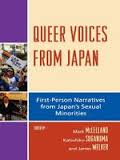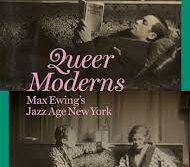 Queer Voices from Japan: First-Person Narratives from Japan’s Sexual Minorities
Queer Voices from Japan: First-Person Narratives from Japan’s Sexual Minorities
Edited by Mark McLelland, Katsuhiko Suganuma, and James Welker
Lexington Books
356 pages, $36.96 (paper)
JAPANESE CULTURE has long accepted the existence of male-male sexual relations and has regarded them as a legitimate erotic outlet for males. By the 17th century, the pursuit of boys by men had become classified as “The Way of Youth” (wakashud), with its own refinements of poetry from the older partner and the gentle bonds of submission and loyalty by the younger. Around the beginning of the 20th century, the public discourse in Japan on male-male sex began moving toward an attitude of disapproval and public avoidance. The Japanese intellectual world was being influenced by psychological and medical theories generated in Europe, where the analysis of human behavior was based on deficit models and personal inner conflict. By the middle of the last century, the lives and loves of people who engaged in same-sex relations had disappeared from society’s view.
The editors of Queer Voices from Japan assembled the book to allow Japan’s sexual minorities past and present to speak for themselves. In their useful introduction, the editors write: “Unlike mainstream communities whose histories constitute official narratives that are passed on via families, churches, schools and community organizations, new generations of queers often have to reinvent themselves. … [O]fficial bodies cannot be relied upon to record the history of these communities, and the result is that they are simply ‘hidden from history.’” Their collection is the product of a thorough scouring of the published literature, which they smoothly translated into English, along with a series of interviews with Japanese activists. The result is a useful and insightful overview of GLBT life in Japan from the 1940’s to the present. Among the most revealing items are the articles published in small magazines in the 1950’s by former soldiers of the Imperial Japanese Army recounting their same-sex erotic adventures during the War. These range from gentle sex-play with an Indonesian boy to sadomasochistic bondage involving senior and junior ranks, and attest to the drive for sexual self-expression in the most improbable of circumstances. The struggle of Japan’s lesbians for self-respect and a sense of community is not neglected. As in other male-dominated cultures, the erotic expressions of women in same-sex relationships were never publicly acknowledged. Lesbians finally struggled to public consciousness in the 1970’s and 80’s through the efforts of some determined women who organized salons, circulated newsletters, and published magazines. The first lesbian social group, “Wakakusa no kai” (“Young Grass”), was organized in 1971. When it disbanded in 1986, other clubs and newsletters arose immediately to take its place. Transgendered people have paradoxically enjoyed more visibility and acceptance in Japan than lesbians. A long tradition of cross-dressing theatrical performances, which continue to this day, prepared people to approach gender-bending with relaxed interest and curiosity. The informative appendix “Timeline of Queer Japan” begins with an entry for 1948, and it cites newspaper reports about transgendered male prostitutes working in Tokyo’s Ueno Park. Many activities of the cross-dressing Elizabeth Club (“erizabesu kaikan”), opened in 1979 in the Kanda section of Tokyo, are described in frank detail by Mitsuhashi Junko, the female persona of the author, whose photo in full female dress appears in the book. In the 1980’s, reacting to the success of Western GLBT activists, many Japanese young people started consciousness-raising groups with activist political agendas. It was an uphill battle to form such groups, in part because Japan’s highly conformist social fabric automatically looks askance at anyone who challenges the status quo. Further, in the absence of gay-bashing or laws against homosexual activity, many Japanese gays felt it was easier just to enjoy the gay bars and numerous cruising spots in the big cities, where police and the public discreetly looked the other way, than to confront a society that was not aggressively anti-gay. But politically aware young gays persisted in holding advertised meetings to discuss their goals for legal equality and recognition and to press for visibility in the form of gay pride parades and film festivals. As a result of this bifurcation in attitudes, two fairly distinct camps have developed among gays in Japan’s larger cities. Those who don’t mind living a closeted life so long as they have all the delights of the widespread gay subculture open to them are reluctant to upset the balance between their public and private lives. Gay activists, on the other hand, look down on those who frequent the gay bars, bookstores, saunas, and rent boys while still living in the closet vis-à-vis family and friends. The most active and successful of the gay-rights organizations is occur, formed in 1986, which won a legal victory in 1991 when they sued the Tokyo metropolitan government for denying them access to public youth facilities. When I was living in Japan in the 1980’s and 90’s, gays throughout the country were linked by the many gay magazines that appeared monthly. Each issue could be as thick as a telephone directory. The front pages usually contained some soft porn according to the magazine’s specialty. For example, Adon (published 1973–96) was for the college crowd, Samson (from 1982) was for the chubby-chasers, G-Men (from 1995) favored muscled he-men. The activist-oriented Za Gei began in 1980, and the general-purpose contact magazine Badi started in 1994. Each issue had articles on gay life and first-person accounts of sexual or social experiences, followed by pages of ads for the gay bars and saunas all over Japan. Then followed the all-important section of personal ads. The most famous of these magazines was Barazoku (“Rose Tribe”), which first appeared in 1971 and dominated this market for over twenty years. But in 2004 Barazoku folded, due largely to competition from the Internet. As elsewhere, these magazines, so vital to gay life twenty years ago, have greatly declined in importance commensurate with the Internet’s ascendancy. Queer Voices from Japan gives an informative and trustworthy account of Japanese GLBT people. It has brought into the light of day many voices which had almost disappeared from history. Ronald Suleski specializes in the field of Asian Studies at Harvard.




